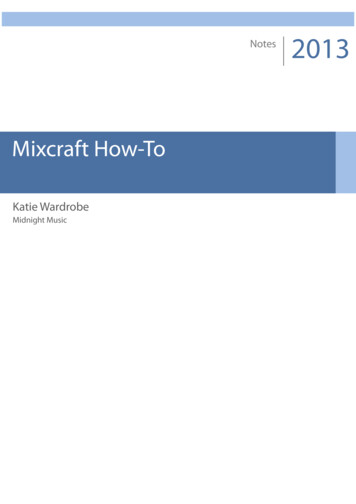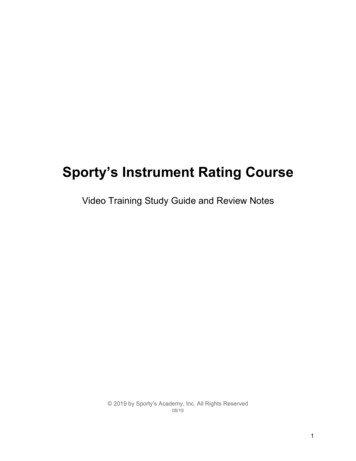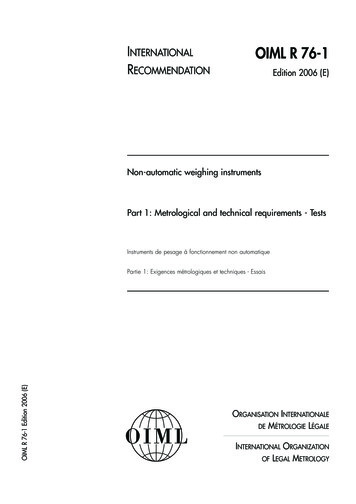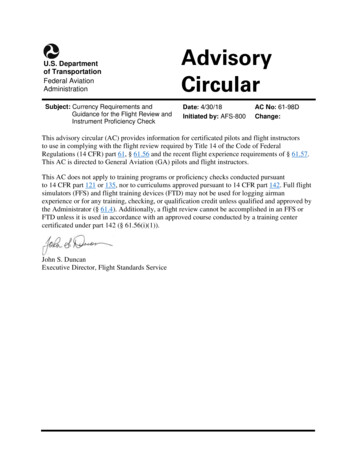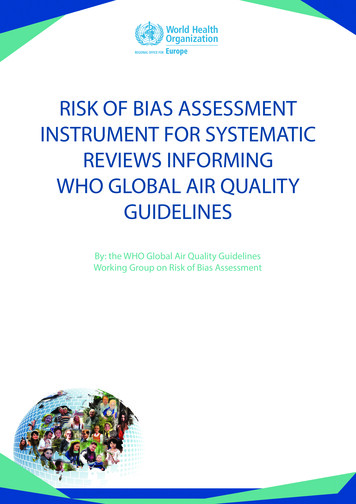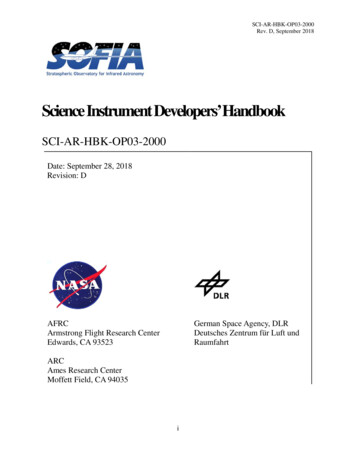
Transcription
SCI-AR-HBK-OP03-2000Rev. D, September 2018Science Instrument Developers’HandbookSCI-AR-HBK-OP03-2000Date: September 28, 2018Revision: DAFRCArmstrong Flight Research CenterEdwards, CA 93523German Space Agency, DLRDeutsches Zentrum für Luft undRaumfahrtARCAmes Research CenterMoffett Field, CA 94035i
SCI-AR-HBK-OP03-2000Rev. D, September 2018Science Instrument Developers' HandbookAUTHOR:Digitally signed by Nancy RustemeyerDate: 2018.09.28 11:05:42 -07'00'Nancy RustemeyerNASA I Nancy Rustemeyer, Deputy SOFIA Science InstrumentDevelopment ManagerDateCONCURRENCE:Digitally signed by ALAN RHODESDate: 2018.09.28 11:34:56 -07'00'ALAN RHODESNASA I Alan Rhodes, SOFIA Science Instrument DevelopmentManagerDateJONATHAN BROWNDigitally signed by JONATHAN BROWNDate: 2018.09.28 12:58:07 -07'00'NASA I Jonathan Brown, SOFIA SE&I LeadDateJOHN RUHFDigitally signed by JOHN RUHFDate: 2018.09.28 13:49:15 -07'00'NASA I John Ruhf, SOFIA Operations ManagerDateMICHAEL TOBERMANDigitally signed by MICHAEL TOBERMANDN: c US, o U.S. Government, ou NASA, ou People,0.9.2342.19200300.100. 1. 1 mtoberma, cn Ml(HAEL TOBERMANDate: 2018.10.01 08:53:50 -08'00'NASA I Michael Toberman, SOFIA Operations DirectorDatesigned by EDWARD STANTONEDWARD STANTON. DigitallyDate: 2018.10.01 10:19:37 -07'00'NASA I Edward Stanton, SOFIA Observatory Systems DirectorDatesigned by EDWARD INGRAHAMEDWARD INGRAHAM DigitallyDate: 2018.10.11 11:10:31 -07'00'NASA I Edward Ingraham, SOFIA S&MA LeadDateDigitally signed by JEANETIE LEJEANETTELEDate: 2018.09.28 12:32:58 -07'00'--------------------NASA I Jeanette Le, SOFIA Chief EngineerDateII
signed by THOMAS ROELLIGTHOMAS ROELLIG DigitallyDate: 2018.10.13 11:18:47 -04'00'Digital signiert von clemens.plank@dlr.deOrt: BonnDatum: 24-10-2018 09:40:24
SCI-AR-HBK-OP03-2000Rev. D, September 2018Revision 017D9/28/2018DESCRIPTIONInitial ReleaseRevision update for Announcement of Opportunityfor SOFIA 3rd Generation Instruments (Phase 1).Change details are provided in Appendix F of thisdocument.Subsequent revision update to support developmentof SOFIA 3rd Generation Science Instruments.Change details are provided in Appendix H of thisdocument.Revision update to support NASA ResearchOpportunities in Space and Earth Sciences (ROSES)research announcement solicitationNNH17ZDA001N-SFNXGNI for SOFIA NextGeneration Instrumentation.Revision update to support proposal finalists fromNASA Research Opportunities in Space and EarthSciences (ROSES) research announcementsolicitation NNH17ZDA001N-SFNXGNI forSOFIA Next-Generation Instrumentation. Thisrevision also incorporates the new SOFIA programagreements documented in the SI DevelopmentDecision Memo and the SOFIA Science InstrumentDevelopment Process and Deliverable Requirements(SOF-NASA-SOW-PM91-2094) Rev -.ivAPPROVALPMB
SCI-AR-HBK-OP03-2000Rev. D, September 2018Contents1Introduction . 1Purpose and scope . 1Terminology . 1SOFIA document library. 22SOFIA Program Overview. 23Instrument Overview . 3Facility Science Instruments . 4PI Science Instruments . 4Technology Demonstration Science Instruments. 44Instrument description. 4Science Instrument System . 4Other equipment. 7Government Furnished Equipment . 75Requirements and interfaces . 8Science Instrument System Specification . 8Science Instrument Process and Deliverable Requirements . 8Science Instrument Performance Specification . 8Interfaces . 95.4.1Introduction . 95.4.2Optical . 125.4.3Mechanical . 125.4.4Pressure . 135.4.5Electrical . 135.4.6Power . 145.4.7Fluidic . 145.4.8Software . 145.4.9Ground Support Equipment . 15Verification and Validation . 1665.5.1Purpose of Verification and Validation. 165.5.2Verification Process Overview . 165.5.3Verification Planning . 175.5.4Verification Preparation, Execution, and Close-Out. 185.5.5Verification Activities . 19Instrument Operations . 27Telescope performance . 27v
SCI-AR-HBK-OP03-2000Rev. D, September 2018Observatory facilities . 276.2.1Science Instrument Labs at AFRC Building 703 . 276.2.2Pre-Flight Integration Facility. 296.2.3Systems Integration Laboratory . 306.2.4Secondary Mirror Buttons . 316.2.5Telescope Tertiary Mirror . 316.2.6Vacuum . 316.2.7Cryocooler. 326.2.8Workspace on aircraft . 32Instrument access during flight . 32Instrument status between flights . 34Commissioning and Guaranteed Observing Times. 34Data Archiving . 34Data Processing . 357Instrument Lifecycle . 35Proposal Preparation and Selection. 357.1.1US Provided Science Instruments . 357.1.2German Provided Science Instruments . 35Science Instrument Advisory Group . 35Instrument Development Lifecycle . 36Instrument Integration and Testing at AFRC . 36SOFIA Observatory Readiness Review . 37Commissioning . 37Post-Commissioning / Pre-Acceptance Support . 38SI Acceptance Process . 38SI Retirement . 388Airworthiness Process . 39Science Instrument Certification: General Process & Overview . 398.1.1Science Instrument Airworthiness Team . 398.1.2Flight Readiness Review. 408.1.3Airworthiness and Flight Safety Review Board. 40SOFIA Contacts . 409Instrument Change Control . 40Instrument Maintenance Logbook . 41Instrument Configuration Sheet . 41Document Configuration Management . 41vi
SCI-AR-HBK-OP03-2000Rev. D, September 201810Environments and Design Guidelines . 41Cabin Environmental conditions . 4210.1.1 Temperature and Humidity . 4210.1.2 Pressure . 42Nasmyth Tube environmental conditions . 43Vibration and Dynamic Environment . 4610.3.1 Quasi-Steady Load Factors . 4710.3.2 Vibrations . 50Electromagnetic Interference / Compatibility . 6511Safety and Mission Assurance . 67Risk-tailored Assurance Approach . 67Mishap Reporting. 68System Safety. 68Shipment . 7111.4.1 Packaging, Packing and Containers . 7111.4.2 Handling and Transportation . 71At AFRC Building 703 . 7111.5.1 Receiving Inspection . 7211.5.2 In the SOFIA Science Laboratories . 7211.5.3 On the Aircraft . 7212Roles and Responsibilities . 72Instrument team/SI developer . 72SOFIA SI Development Manager . 73SOFIA Systems Engineering and Integration . 73SOFIA Safety and Mission Assurance. 73SOFIA Science Instrument Airworthiness Team. 73Instrument Scientists . 74Mission Operations . 74Appendix A.1 – {Deleted} . 76Appendix A.2 – {Deleted} . 76Appendix B – Acronyms . 76Appendix C – Rack & Patch Panel Distances . 82Appendix D – {Deleted} . 86Appendix E – {Deleted}. 86Appendix F – SI Developer’s Handbook, Rev. – to A Change Details. 87Appendix G.1 – {Deleted} . 90vii
SCI-AR-HBK-OP03-2000Rev. D, September 2018Appendix G.2 – {Deleted} . 90Appendix G.3 – {Deleted} . 90Appendix G.4 – {Deleted} . 90Appendix H – SI Developer’s Handbook, Rev. A to B Change Details . 91Appendix I – SI Developer’s Handbook, Rev. B to C Change Details . 94Appendix J – SI Developer’s Handbook, Rev. C to D Change Details. 97Appendix K – Chart Content Guidelines for Reviews . 98viii
SCI-AR-HBK-OP03-2000Rev. D, September 20181 IntroductionPurpose and scopeThe Science Instrument Developers’ Handbook describes how to develop a science instrument (SI)for the NASA/DLR Stratospheric Observatory for Infrared Astronomy (SOFIA) Program. The handbookprovides an overview of the SOFIA instrument program and references all necessary requirement andinterface documents for instrument developers; but, the handbook does not supplant the requirements andinterface documents. This document contains narrative descriptions of some processes and is intended toassist instrument teams with understanding the requirements and to provide guidance on the design anddevelopment of SOFIA instruments. The handbook applies to US and German instruments, except whereindicated – “only for US instruments” or “only for German instruments”.This handbook is intended to be a guide and roadmap for instrument developers interested in thefollowing aspects of SOFIA instruments: Developing or completing the development of instrumentsProposing future instruments under an Announcement of Opportunity or other callProposing enhancements to existing SOFIA and/or other instruments to be adapted to operateon SOFIAProcedural elements and reviews to be performed for new and/or upgraded instrumentsOverview information concerning SOFIA interfaces and recommendations for optimizationbased on instrument typeTypically, work for new instruments (as well as for modifications to existing instruments), will beperformed via external contracts. The SOFIA Science Instrument Development Process and DeliverableRequirements (SOF-NASA-SOW-PM91-2094) and the SOFIA Science Instrument System Specification(SOF-AR-SPE-SE01-2028) would become the basis for any contractual Statement of Work (SOW).TerminologyIt is important to note that this handbook does not define any requirements but does provide guidanceand context for applicable SI requirements defined in other SOFIA documents.Appendix B – Acronyms contains a list of the acronyms and abbreviations used in this handbook.The SOFIA Lexicon (SOF-DF-PD-PD-2009) contains a more extensive list of the acronyms,abbreviations, and definitions of terms used by the SOFIA Program.The science instruments are frequently abbreviated as “SI.” The term “PI” is often used to describeitems related to the Science Instrument Principal Investigator (i.e., PI rack, PI patch panel). There areother Principal Investigators associated with the SOFIA Observatory. Any reference to the PI in thisdocument refers to the Science Instrument Principal Investigator unless otherwise noted.When describing relative locations on the aircraft, we will use the terms: fore, aft, port, and starboard.Port is on your left when facing the front of the plane and on your right when facing aft toward thetelescope. Many of the seats on the Observatory face aft, thus using “right” and “left” may generateconfusion. Just remember that the telescope looks out “the port” side of the airplane.1
SCI-AR-HBK-OP03-2000Rev. D, September 2018Instrument Team or SI developer– refers to the Science Instrument team working for the instrumentPrincipal Investigator to build an individual instrument.SOFIA Science Instrument Development Team – refers to the Observatory staff that works at theSOFIA Science Center (NASA Ames Research Center) and at the SOFIA Operations Center (NASAArmstrong Flight Research Center Building 703) and reports to the SOFIA Science InstrumentDevelopment Manager. The SOFIA SI Development Team consists of personnel from NASA, USRA,and other contractors.Instrumentation – refers to sensors on the aircraft to measure parameters such as temperature,pressure, acceleration, etc. To clearly distinguish between aircraft and test instrumentation and thescience instruments mounted on the telescope, the latter is referred to as the Science Instrument (SI).Safety Critical— is defined as, a failure to meet the flight hardware or software requirements for thatcharacteristic could cause or lead to severe injury, major damage, or mission failure if performed or builtimproperly, or allowed to remain uncorrected. The loss of the SI by itself does not constitute a missionfailure.SOFIA document libraryNASA maintains the SOFIA Program document library using servers running Windchill software.This library is located at https://sofiacm.arc.nasa.gov and is accessible from the NASA network or using aVPN connection to the NASA network. Each instrument team should have team members withWindchill accounts so the team has access to the full SOFIA document library and the latest documentversions.Instrument teams should contact the SOFIA SI Development Manager for information on obtainingan account on Windchill. Tutorials and training materials for using Windchill are available in the /.Helplibrary on Windchill.2 SOFIA Program OverviewSOFIA consists of a German‐built 2.7‐meter (2.5-meter useable) telescope mounted in a Boeing 747‐SP aircraft supplied and modified by NASA. Operations costs and observing time are shared by theUnited States (80%) and Germany (20%). Flying at altitudes up to 45,000‐feet, SOFIA observes fromabove more than 99 percent of Earth’s atmospheric water vapor, thereby opening windows to the universenot available from the ground. SOFIA offers international science teams approximately 1000 cloud‐freehigh‐altitude science observing hours per year during its two decade design lifetime. Science proposalswill be selected through a competitive peer review process. Although the primary impact of SOFIA willbe its science return, it will yield other returns as well. Compelling discoveries will follow thedevelopment of new technologies that can be demonstrated readily on SOFIA. Young scientists‐in‐training, educators, and journalists will also fly on SOFIA, making it a valuable training platform andpublic ambassador.SOFIA observes at wavelengths from 0.3 μm to 1.6 mm. SOFIA’s diffraction‐limited imaginglongward of 25 μm can produce the sharpest images of any current or planned IR telescope operating inthe 30 to 60 μm region.2
SCI-AR-HBK-OP03-2000Rev. D, September 2018The SOFIA Observatory concept embodies a number of key advantages that make it a unique tool forastronomy in the coming decades: SOFIA is a near‐space observatory that comes home after every flight. Its scientific instrumentscan be exchanged regularly, accessed for repairs or cryogenic servicing, to accommodate changingscience requirements, and to incorporate new technologies. SOFIA has unique capabilities for studying transient events. The observatory can operate onshort notice from airbases worldwide, in both the northern and southern hemispheres, to respond to newand transient scientific opportunities. SOFIA’s diverse range of instrumentation facilitates a coordinated program of analysis of specifictargets and science questions. SOFIA’s 20‐year design lifetime enables long‐term studies and follow‐upof work initiated by SOFIA itself and by other observatories, such as the Hubble Space Telescope,Chandra X-ray Observatory, Spitzer Space Telescope, Herschel Space Observatory, Submillimeter Array,and Akari (Astro‐F), as well as future facilities. SOFIA presents an ideal venue in which to educate students, where they can participate in hands‐on, cutting‐edge space technology developments. Because of its accessibility, SOFIA includes a vigorous, highly visible Education and PublicOutreach (E/PO) program designed to exploit the unique and inspirational attributes of airborneastronomy (see ch).SOFIA, with its large suite of science instruments and broad wavelength coverage, is capable ofundertaking a huge breadth of different investigations.The Science Vision for the Stratospheric Observatory for Infrared Astronomy (USRA-DAL-SSMOCSCIN-REP-1018) summarizes the unique capabilities that SOFIA will offer to the astronomicalcommunity, and describes a number of exciting science programs that are representative of SOFIA'spotential contributions. It and additional general information on SOFIA may be found athttps://www.sofia.usra.edu.A description of the SOFIA Program organization structure can be found in the Program Plan forSOFIA (SOF-DF-PLA-PM01-1000).The SOFIA Concept of Operations (SOF-DA-PLA-PM17-2000) is a useful resource forunderstanding the SOFIA Observatory System, the Operational Phases section may be of particularinterest as it provides an overview of observatory certification and commissioning, flight seriespreparation, science mission operations, and post-flight operations, all of which a science instrument andinstrument team are an integral part of.3 Instrument OverviewThe SOFIA Observatory supports a complement of instruments, which are categorized into classesdepending on how the instrument is to be used. The three classes are: Facility-class SI (FSI), PrincipalInvestigator-class SI, and Technology Demonstration-class SI. This handbook reflects changes to theseearlier classification of science instruments stemming from the 2017 Research Opportunities in Space andEarth Sciences (ROSES) NASA Research Announcement (NRA) solicitation for SOFIA Next GenerationInstrumentation. The new Next-Generation Science Instruments (NGSI) to be used in the SOFIA3
SCI-AR-HBK-OP03-2000Rev. D, September 2018extended mission has eliminated these classifications in favor of a single and simpler developmentapproach.The solicitation provides a comprehensive summary of the proposal, development, commissioning,and acceptance process for SOFIA instruments; refer to the solicitation for timeline and details.Certain aspects of the new development process are highlighted here in the handbook to reinforcesome of the key aspects of NGSI development, in particular ownership of the instrument will transition tothe SOFIA Program through an acceptance process following completion of instrument commissioningand the instrument’s Legacy Science Program (LSP), a period of usage of the instrument by the generalscience community, and completion of documentation deliverables. The time period from when aninstrument proposal is selected for development to delivery of the instrument for commissioning isapproximately 3 years; the transition of the instrument to the SOFIA Program, including the completionof the LSP and earlier mentioned items, will occur approximately 2 years thereafter.Facility Science InstrumentsThis categorization applies to instruments that have completed the Acceptance Review and havetransitioned to the SOFIA Program to maintain and operate.PI Science InstrumentsPrincipal investigator science instruments (PSI), or PI-class SIs, refers to the science instrument whenit is still under the control of the PI. When in this category the instrument developer is responsible for thedevelopment, operation, and maintenance of the instrument, including operation of the instrument forgeneral observer (GO) science observations.NGSI development and management will closely follow the development approach for PI-classinstruments up until the instrument transitions to NASA and is accepted as an FSI.Technology Demonstration Science InstrumentsTechnology demonstration science instruments (TDSI) are developed for the purpose of maturing anddemonstrating, through a focused science investigation involving a limited number of SOFIA flights, newcapabilities and methodologies of value to SOFIA and future NASA missions.4 Instrument descriptionScience Instrument SystemA SOFIA Science Instrument System installed onboard SOFIA generally consists of the followinghardware components: Instrument Assembly – the portion of the instrument that mounts to the telescope assemblyinstrument mounting flange. The instrument assembly includes the instrument optical bench,cryostat(s), detectors, and electronics. Once installed, the instrument assembly will movewith the telescope and thus will need to operate through the operating range of the telescope4
SCI-AR-HBK-OP03-2000Rev. D, September 2018assembly. Access to the instrument assembly during fligh
NASA maintains the SOFIA Program document library using servers running Windchill software . This library is located at https://sofiacm.arc.nasa.gov and is accessible from the NASA network or using a VPN connection to the NASA network. Each instrument team should have team members with
